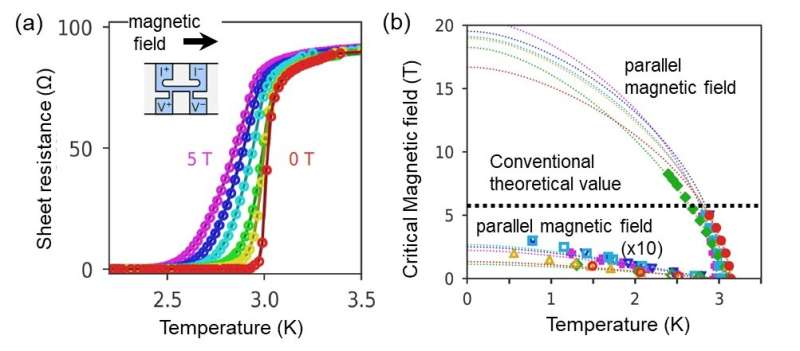Discovery of a mechanism for making superconductors more resistant to magnetic fields

Superconductivity is known to be easily destroyed by strong magnetic fields. NIMS, Osaka University and Hokkaido University have jointly discovered that a superconductor with atomic-scale thickness can retain its superconductivity even when a strong magnetic field is applied to it. The team has also identified a new mechanism behind this phenomenon. These results may facilitate the development of superconducting materials resistant to magnetic fields and topological superconductors composed of superconducting and magnetic materials.
Superconductivity has been used in various technologies, such as magnetic resonance imaging (MRI) and highly sensitive magnetic sensors. Topological superconductors, a special type of superconductor, have been attracting great attention in recent years. They are able to retain quantum information for a long time and can be used in combination with magnetic materials to form qubits that may enable quantum computers to perform very complex calculations. However, superconductivity is easily destroyed by strong magnetic fields or magnetic materials in close proximity. It is therefore desirable to develop a topological superconducting material resistant to magnetic fields.
The research team recently fabricated crystalline films of indium, a common superconducting material, with atomic-scale thickness. The team then discovered a new mechanism that prevents the superconductivity of these films from being destroyed by a strong magnetic field. When a magnetic field is applied to a superconducting material, the magnetic field interacts with electron spins. It causes the electronic energy of the material to change and destroys its superconductivity. However, when a superconducting material is thinned to a two-dimensional atomic layer, the spin and the momentum of the electrons in the layer are coupled, causing the electron spins to frequently rotate. This offsets the effect of the changes in electronic energy induced by the magnetic field and thus preserves superconductivity. This mechanism can enhance the critical magnetic field—the maximum magnetic field strength above which superconductivity disappears—up to 16-20 Tesla, which is approximately triple the generally accepted theoretical value. It is expected to have a wide range of applications as it was observed for an ordinary superconducting material and does not require either special crystalline structures or strong electronic correlations.
Based on these results, we plan to develop superconducting thin films capable of resisting even stronger magnetic fields. We also intend to create a hybrid device composed of superconducting and magnetic materials that is needed for the development of topological superconductors: a vital component in next-generation quantum computers.
More information: Shunsuke Yoshizawa et al, Atomic-layer Rashba-type superconductor protected by dynamic spin-momentum locking, Nature Communications (2021). DOI: 10.1038/s41467-021-21642-1
Journal information: Nature Communications
Provided by National Institute for Materials Science





















